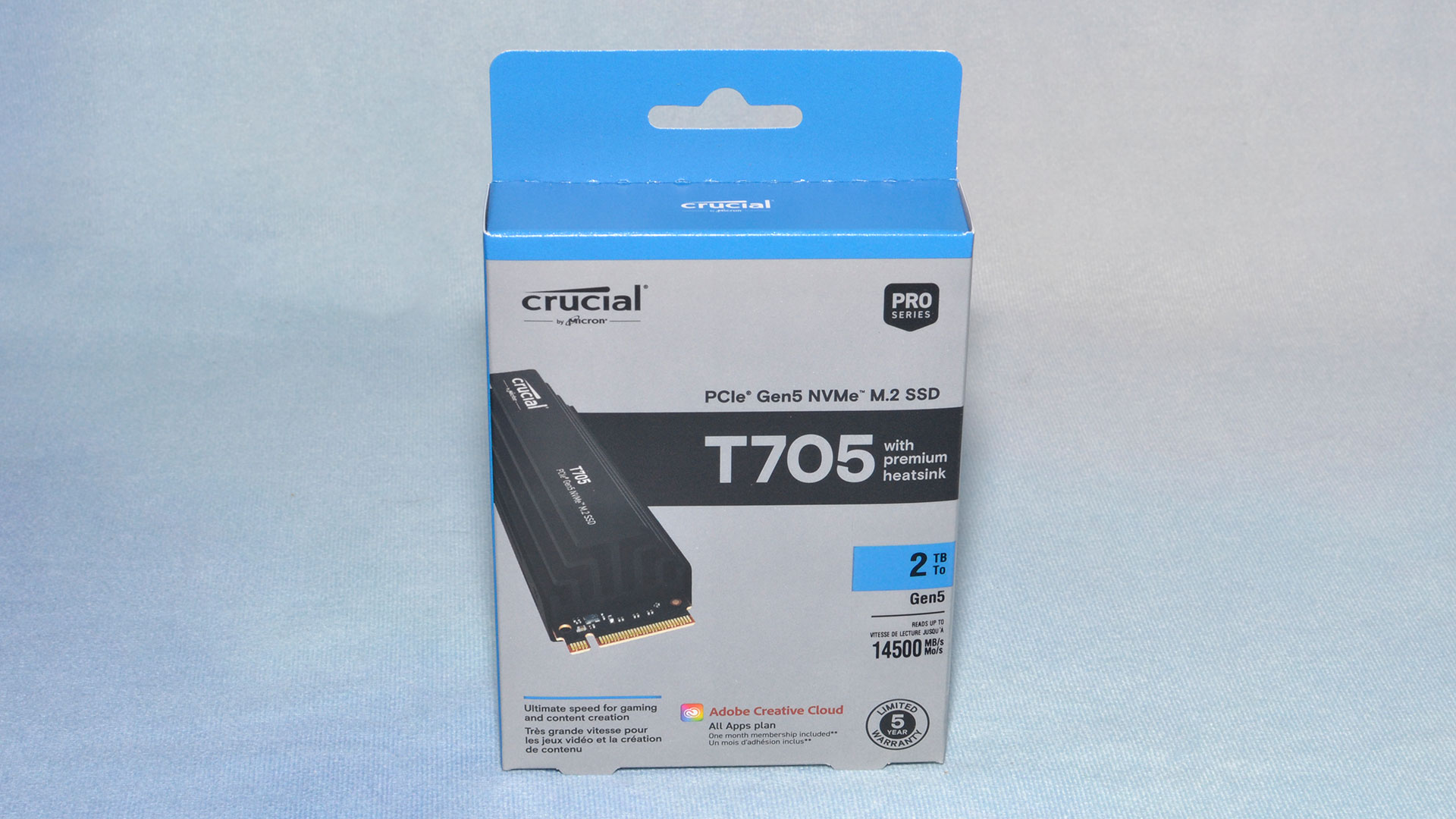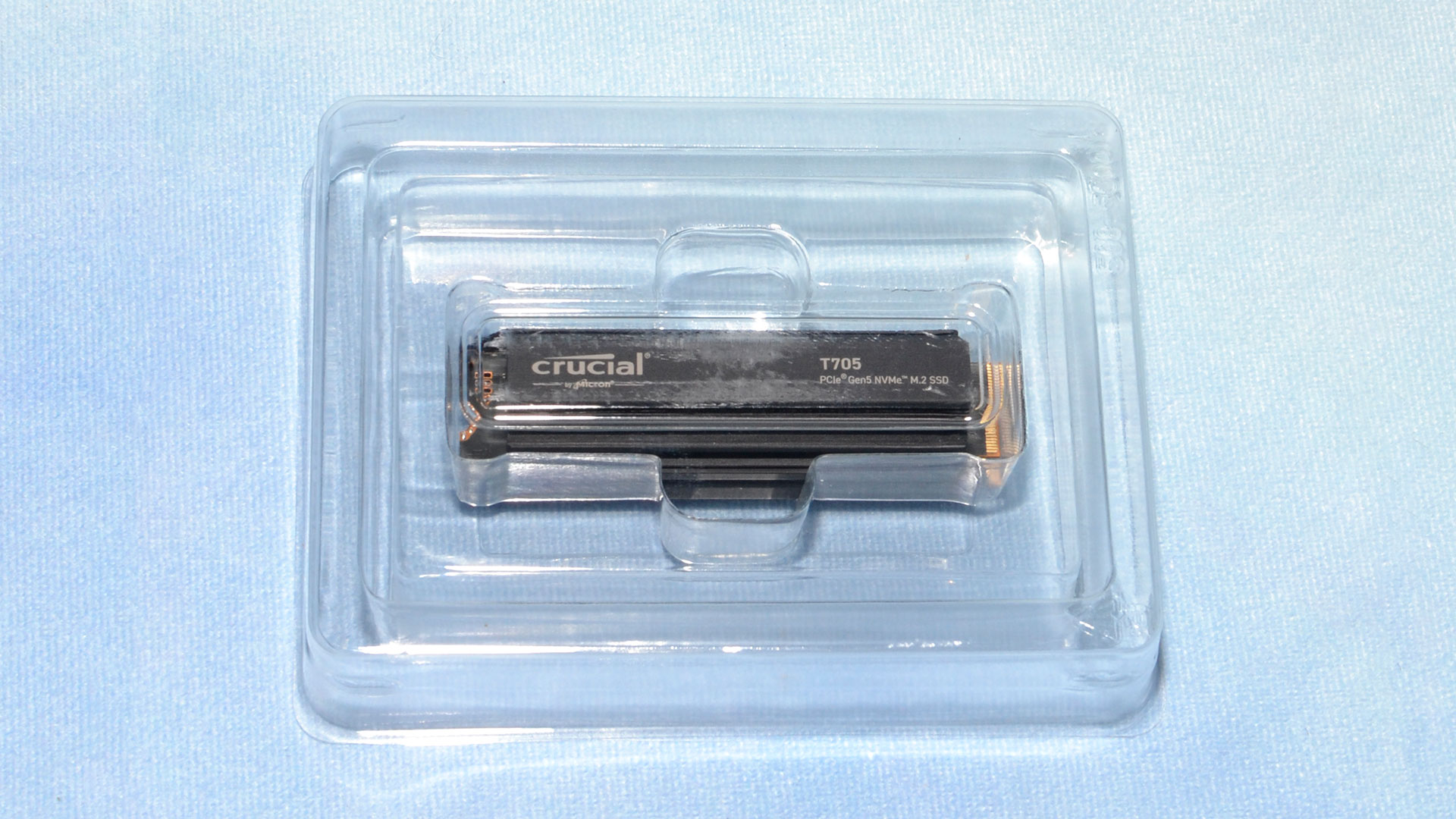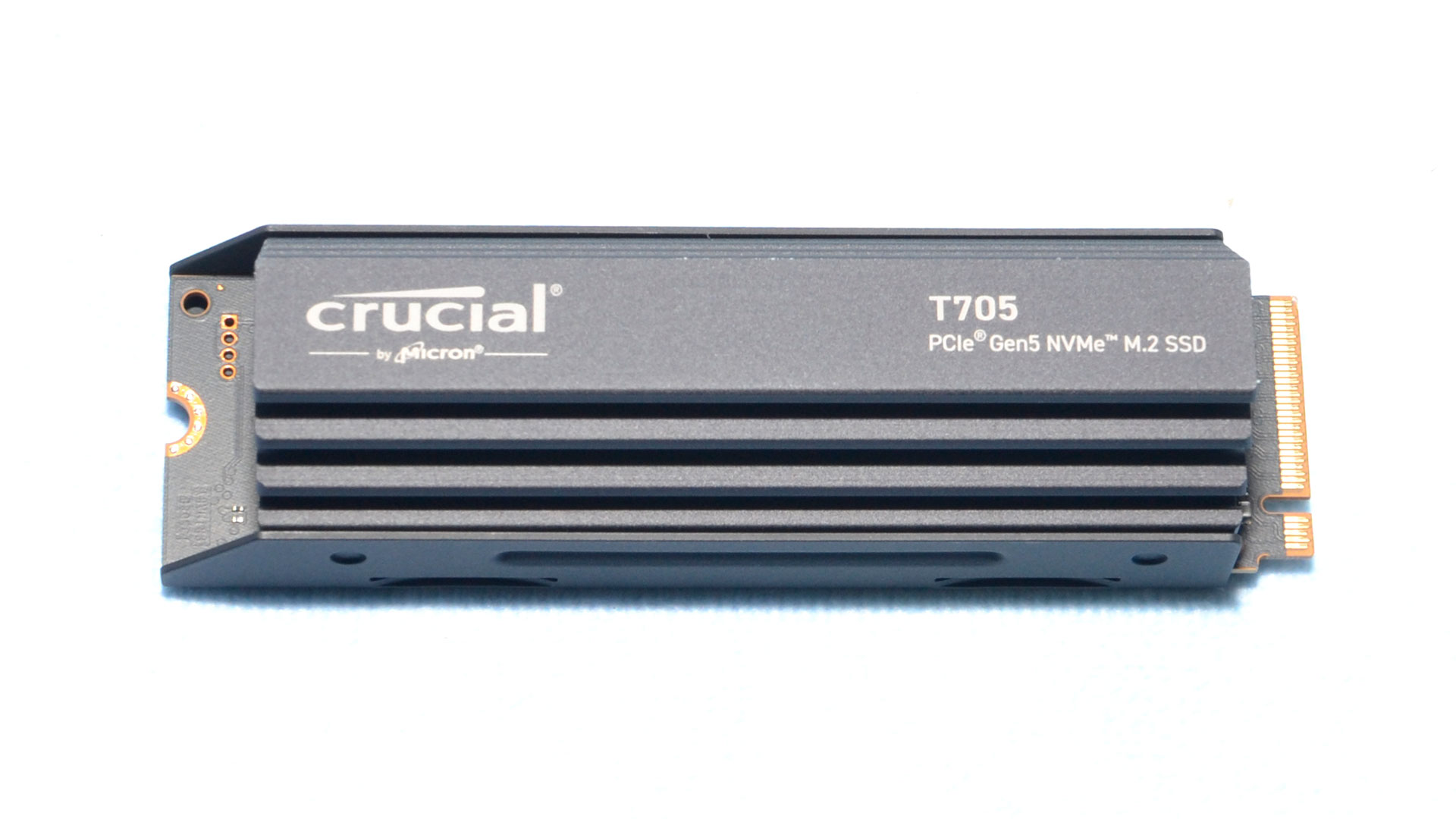Tom's Hardware Verdict
The Crucial T705 is the fastest SSD we’ve ever tested. It pushes the limits of what a PCIe 5.0 SSD can do, and does it right, although that comes with a big price tag.
Pros
- +
Great all-around and sustained performance
- +
Multiple varieties available
- +
Up to 4TB for a high-performance drive
- +
Encryption and software support
Cons
- -
High MSRP for all capacities
- -
High power consumption and heat production
Why you can trust Tom's Hardware
The Crucial T705 SSD comes as a piece of technology that feels like it makes everything that came before it obsolete. Storage may not be the most exciting part of your high-end PC build, but it has become a central part of the equation now that the limitations of hard drives have been left completely behind. Multi-terabyte, super-fast solid state drives provide the best possible experience for applications, games, and file transfers. Of those drives the T705 is, today, the new performance master of the best SSDs.
Bumping up a little bit from the existing Crucial T700 may not seem like much of an improvement, but that’s not the point. The T705 represents the current pinnacle of PCIe 5.0 SSD design, requiring plenty of research and development from both Phison and Micron — we previewed the Phison Max14um reference design earlier this year. It pushes the limit of what’s possible with a 5.0 link. In that regard, achieving over 14 GB/s really is a leap over what’s come before. The T705 also performs exceptionally well over last-generation drives in almost every way.
Any criticism of this as hyperbole will probably point to the “real world” experience and the fact that NAND flash has not seen leaps of improvement with the important random 4K QD1 performance. In fact, 4K performance has improved significantly in recent years, and DirectStorage looks like it will — eventually — adapt systems to get more out of flash’s peculiarities. The T705 is therefore not a leap in the traditional sense, but more of a milestone and harbinger of more efficient drives with better game and application performance. It sets the stage for a new baseline.
It’s also not a drive for everyone. You won’t be picking it up for your laptop or PS5. If you just need a bunch of storage with better-than-HDD performance, there are many less-expensive SSDs available in its capacity range — check our SSD benchmarks hierarchy for details. The T705 can be a suitable upgrade from an SATA or PCIe 3.0 SSD, sure, but right now PCIe 4.0 SSDs make more sense for most users. Instead, this drive is for the enthusiast who wants the very fastest storage possible, even among the PCIe 5.0 options. Other fast drives are coming, but the T705 got here first — and most of those "other drives" will likely have the same hardware as the T705 anyway.
Crucial T705 specifications
| Product | 1TB | 2TB | 4TB |
|---|---|---|---|
| Pricing | $239.99/$259.99 | $399.99/$439.99 | $689.99/$729.99 |
| Variants | Bare, Heatsinked | Bare, Heatsinked | Bare, Heatsinked |
| Form Factor | M.2 2280 | M.2 2280 | M.2 2280 |
| Interface / Protocol | PCIe 5.0 x4 | PCIe 5.0 x4 | PCIe 5.0 x4 |
| Controller | Phison E26 | Phison E26 | Phison E26 |
| DRAM | LPDDR4 | LPDDR4 | LPDDR4 |
| Flash Memory | 232-Layer Micron TLC | 232-Layer Micron TLC | 232-Layer Micron TLC |
| Sequential Read | 13,600 MB/s | 14,500 MB/s | 14,100 MB/s |
| Sequential Write | 10,200 MB/s | 12,700 MB/s | 12,600 MB/s |
| Random Read | 1,400K | 1,550K | 1,500K |
| Random Write | 1,750K | 1,800K | 1,800K |
| Security | TCG OPAL 2.01 | TCG OPAL 2.01 | TCG OPAL 2.01 |
| Endurance (TBW) | 600TB | 1,200TB | 2,400TB |
| Part Number | CT1000T705SSD3/5 | CT2000T705SSD3/5 | CT4000T705SSD3/5 |
| Warranty | 5-Year | 5-Year | 5-Year |
The Crucial T705 arrives at 1TB, 2TB, and 4TB capacities, in both heatsink and bare models for all sizes. The 4TB option is especially nice as it’s been challenging to find that much flash in the very fastest drives. This drive is certainly one of those, capable of reaching up to 14,500 / 12,700 MB/s for sequential reads and writes and up to 1,550K / 1,800K random read and write IOPS (though the 4TB model is slightly slower than the 2TB model). These numbers would have been unthinkable several years ago.
The T705 has the standard five-year, 600TB of writes per TB capacity warranty. The drive does support TCG OPAL 2.01 for encryption. This feature makes sense given the controller’s enterprise origins, although it’s unclear if it will be available on all drives using this hardware as traditionally it has been an optional feature.
Perhaps the most salient specification, though, is cost. Crucial’s MSRPs are listed as $239.99/$259.99, $399.99/$439.99, and $689.99/$729.99, for the three capacities both without and with heatsink. As you will probably be shooting for at least 2TB, that’s a $40 upgrade for the heatsink. You can certainly do better than that with your own solution. Even with rising SSD and NAND flash prices, the low gigabytes per dollar factor here is quite underwhelming. You will have to pay dearly for cutting-edge SSD performance.
Crucial T705 software and accessories
Crucial does a good job of providing competent software for its SSDs. The main SSD toolbox is called the Crucial Storage Executive, which has all the expected features. These include drive health management, the ability to work with encryption and security features, firmware updates, and more. Crucial also supports secure firmware updates and the ability to verify legitimate hardware. For imaging and cloning, Crucial provides Acronis True Image for Crucial, an effective OEM tool that makes life a little easier.
Crucial T705 — A closer look


The Crucial T705 is packaged securely. Some other drives may come with an M.2 screw, but these screws should be found with your motherboard. After all, this drive is made for high-end desktops, so you should already have everything you need.
Crucial has both heatsink and bare versions of the drive so you can use your own cooling solution, including a motherboard M.2 heatsink, if desired. Additionally, Crucial has a limited edition drive with white heatsink available, if your build demands that aesthetic.
Cooling is required for the T705 to operate properly and achieve full performance. While Phison has improved the firmware to prevent E26 drives from crashing if they get too hot, throttling under heavier workloads can be quite severe on a bare drive.



The heatsink is familiar, matching Crucial’s custom design from the T700. Perhaps its most important feature is that it provides passive cooling. There’s no fan needed here. It’s sometimes mistakenly believed that these ultra-fast PCIe 5.0 SSDs require active cooling. Thankfully, they don’t, as small fans can be annoying.
That said, Phison — the controller and drive reference designer — is on record saying these newer fans are designed to be quieter, avoiding the high-pitched, high-RPM sound that one might expect. Alternatively, a PC with a modest amount of airflow near the M.2 slots, either from case fans or a nearby graphics card, should be sufficient.
The drive is rated for 3.5A at 3.3V for around 11.55 watts maximum, which is a power limit Phison had to design around with its Max14um reference SSD. Average power consumption is lower and can be handled by the built-in heatsink. More efficient drives are on the horizon, but this level of performance doesn’t come free.
The T705 is otherwise using the expected Phison E26 SSD controller, an eight-channel design with DRAM, and Micron’s 232-Layer TLC NAND flash. This is high-end hardware and it’s being pushed to its limits. The full bus speed of 2,400 MT/s is required to hit over 14,000 MB/s. This is an impressive achievement and will help pave the way for more efficient designs in the months and years to come. For now, it can provide the absolute bleeding edge of consumer storage performance.
MORE: Best SSDs
MORE: Best Hard Drive
Get Tom's Hardware's best news and in-depth reviews, straight to your inbox.
MORE: Best SSD for the Steam Deck
- 1
- 2
Current page: Crucial T705 Features and Specifications
Next Page Crucial T705 2TB Performance Results
Shane Downing is a Freelance Reviewer for Tom’s Hardware US, covering consumer storage hardware.
-
PEnns Sounds great. But...what did Crazy Eddy say (those who were born before the 1990s will remember him ;)) ?Reply
Those Prices Are Insane!! -
Notton I'm kind of curious. Who buys these top end Gen5 drives?Reply
A top end Gen4 is significantly cheaper and is only microseconds slower at loading Windows/Games. -
Roland Of Gilead 'The 4TB option is especially nice as it’s been challenging to find that much flash in the very fastest drives. This drive is certainly one of those, capable of reaching up to 14,500 / 12,700 MB/s for sequential reads and writes and up to 1,550K / 1,800K random read and write IOPS. 'Reply
Might just be the way I'm reading it, but you mention the 4TB and then go on to describe it using the speeds of the 2TB version.
Sorry, I'm being pedantic. -
gg83 Where is the majority of the cost from? The controller? Do gen 5 drives use the same nand as gen4? Maybe thicker pcb and more expensive metals?Reply -
warezme Reply
Greed.gg83 said:Where is the majority of the cost from? The controller? Do gen 5 drives use the same nand as gen4? Maybe thicker pcb and more expensive metals? -
kiniku Reply
I am pleased with my T700 purchase. $299.00 for 2TB? Are you kidding me? In 3 years it will be $169.00 on Black Friday.Admin said:The Crucial T705 is a very fast, if very expensive, PCIe 5.0 SSD. If you want the all-around fastest SSD on the planet, this is it for now, although that ownership comes at a price.
Crucial T705 2TB SSD Review: The Fastest SSD on The Planet : Read more -
kiniku Reply
Many users are moving large files back and forth, or are manipulating them, and every second saved can make a difference. But for most of us gamers you're right, the experienced delta and cost thereof isn't worth it. Having the "fastest" is an early adopter tax for those with deep pockets that the manufacturer is hoping will help them recoop their development costs, aka the price of developing, manufacturing, and offering the "fastest".Notton said:I'm kind of curious. Who buys these top end Gen5 drives?
A top end Gen4 is significantly cheaper and is only microseconds slower at loading Windows/Games. -
anonymousdude ReplyNotton said:I'm kind of curious. Who buys these top end Gen5 drives?
A top end Gen4 is significantly cheaper and is only microseconds slower at loading Windows/Games.
People with deep pockets and people who chase after specs. The only people that benefit from these drives at the moment are those with workloads where it benefits them or outright requires them. On other words, you use it for work where every second matters, your company has more money than sense, or some combination of both. -
BillyBuerger Their pricing with/without heatsink seems a bit random. Assuming they use the same heat sink for the different models, you would expect the same price increase to include it. But it's not. It's $20 extra for the 1TB and $40 extra for 2TB and 4TB according to the article pricing. I checked Crucial's site and it lists the non-heatsink 4TB for $714 which is only $16 extra for the heat sink. WTF?Reply -
Albert.Thomas I feel like we should have some benchmarks of Optane U.2 drives included with these results :DReply